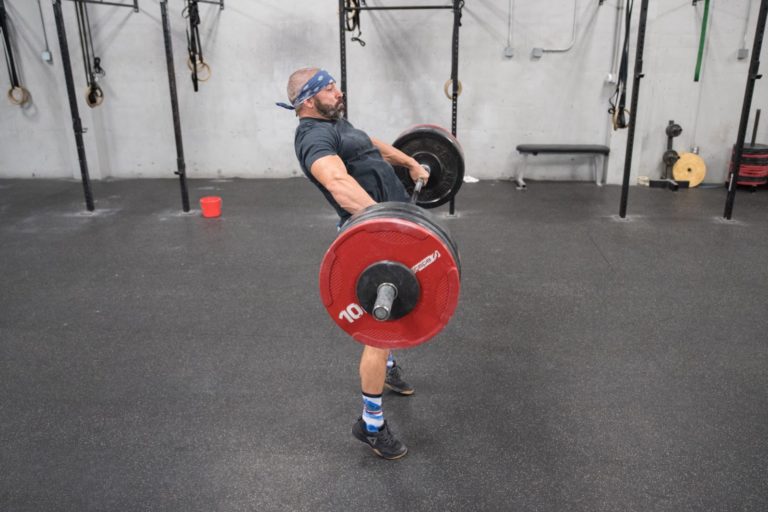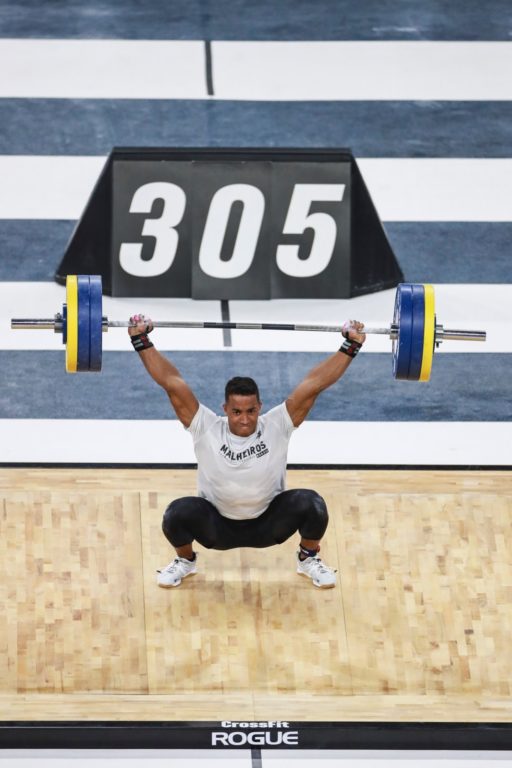Burgener regularly teaches adolescents and “newbies” how to high-hang snatch beautifully in minutes and how to do the full movements properly in a few weeks. He accomplishes this with much repetition, coaching, and the use of proper loading and rep schemes. In a relatively short period of time, Burgener’s athletes are able to prudently venture into high-rep Olympic lifting because they have ingrained the fundamental positions — they know how to set their back, move the bar, and receive the bar. They are also able to display sound technique rep after rep and to receive coaching on the fly to adjust technique as needed. These athletes understand when to slow down or rest — or even decrease weight — to prevent unacceptable technique faults such as rounding the low back, not receiving the bar properly, or using footwork that puts the knees, ankles, or hips in precarious positions.
Myth 2: High-Rep Olympic Lifts Are a Poor Conditioning Method
CrossFit uses high-rep Olympic lifts as a phenomenal conditioning tool. Coach Burgener says, “I don’t think there’s a better test for strength endurance” while adding that high-rep Olympic lifts) “develop tremendous work capacity and have major carryover to everything else. They make everything … better.”
Burgener is not the only high-level weightlifting coach who values the benefits of high-rep Olympic lifts. Jim Schmitz, a former U.S. Olympic weightlifting team coach, espouses performing sets of 10 in the clean and jerk for cardiovascular fitness and muscular endurance.
Critics of high-rep Olympic lifts claim there are much better ways to condition athletes, like hill sprints and sled pushes. Sled pushes and pulls and hill sprints are great conditioning tools that definitely have a place in a strength and conditioning program. However, these low-skill movements do not hone the most important quality a conditioning program should deliver: the ability to handle complex tasks with proper technique in a fatigued state.
The ability to maintain impeccable technique during an entire competition is the mark of every great athlete who has the label “well-conditioned” bestowed upon them, whether in the context of fighting, basketball, football, soccer, or hockey. In the heat of competition, late in the game, as an athlete’s fatigue mounts and technique begins to degrade, the athlete must be able to accept external cues from a coach or provide their own internal cues to preserve the technique required to prevail. An athlete who demonstrates this ability in action is seen as conditioned, whereas an athlete who cannot maintain or fix technique as they tire appears out of shape or not well prepared. To be clear, demonstrating proper technique under stress and fatigue is not a skill reserved for professional athletes. Anyone who wants to perform at their best in their chosen physical activity, whether it is jogging, a favorite hobby, CrossFit in the garage, or flag football, must hone this skill.
Learning how to manage fatigue while displaying optimal technique can only be trained by practicing complex tasks while fatigued. In practice, football and basketball players train precise footwork, keep their hips low, and maintain proper posture as they fatigue. In sparring, martial artists work on maintaining proper footwork, takedowns, kicking, and striking combinations as they fatigue. Soldiers shoot and move with great precision while fatigued. Consider high-quality, high-rep Olympic lifting a general-physical-preparedness (GPP) method of conditioning with no equal in developing the crucial ability to properly perform complex tasks while fatigued.
Those who have performed high-rep Olympic lifts immediately recognize the benefits of this style of training. With hill sprints and sled pushes, the athlete definitely has to strain and provide maximal effort. However, the brain needs to do very little other than think “drive the legs!” or “keep pushing!” and register the burning sensation in the legs and lungs. With a set of high-rep Olympic lifts, the brain cannot shut off and simply cheer. On every snatch or clean and jerk in a high-rep set, the athlete must assess their position every second, evaluate their technique from moment to moment, and adjust as needed on the fly. Rep after rep. This process is extremely taxing mentally. Many athletes don’t even realize how fatigued they are until they’ve completed all the reps because they have been focusing so hard on their technique. This is exactly the mental approach all athletes, whether professional or recreational, should bring to competition and everyday activities.
As a conditioning method, high-rep Olympic lifts flat-out work. Besides forcing athletes to focus on technique under stress and fatigue, these lifts are full-body, explosive movement patterns with no peer in developing athleticism. They are also a great method for training an athlete’s repetitive explosive power or ability to give maximum effort, recover during a short rest period, and repeat that maximal effort over and over without a decline in performance. Repeated maximal efforts with short recovery are critical for success in most sports. Top strength coaches, such as Josh Everett and Ethan Reeve, use high-rep Olympic lifts to develop repetitive explosive power in their athletes. For example, a set of 2 power cleans on the minute for 12 to 15 minutes almost perfectly simulates the total work as well as the work-to-rest ratio experienced on a typical drive down the field in football. The cleans are performed explosively, aggressively, and with great technique to mimic the demands of a play. This is highly effective conditioning for sport. This type of training also transfers incredibly well to everyday life and preparing for unknown and unknowable tasks we can’t predict but need to be ready for.
Myth 3: High-Rep Olympic Lifts Hurt Technique in the Classic Lifts
There are a few differences in technique between the high-rep version of the Olympic lifts and the classic lifts used in competition for maximal load. Athletes performing high-rep Olympic lifts tend to set up with their hips a little higher in more of a deadlift position than the “squatty” starting position used for maximal lifts. The higher-hip starting position helps save the legs from fatiguing and makes it easier to breathe in the bottom position. It is also the most efficient position for the touch-and-go reps many athletes use to string reps together. Also, the feet tend to stay in the same spot during high-rep lifts instead of sliding from the jumping position to the squat position as in maximal lifts.
These are minor variations that have evolved to support the task of moving submaximal weight for reps, quickly. The major components of the lifts, including how the bar is received in the top position, the strong low-back position, and the triple extension of the ankles, knees, and hips to generate vertical momentum on the bar, all remain consistent regardless of whether the goal is maximal load or total reps. Instead of being detrimental, as some claim, to one’s technique in the max clean and jerk or snatch, high-rep Olympic lifting can help athletes improve their technique in a few notable ways.
First, as an athlete fatigues during a high-rep set, they must focus on executing a strong, explosive finish with the second pull to get the bar into the receiving position. It is not uncommon for athletes to learn how to really “finish” for the first time in this fatigued state.

A great finish position



